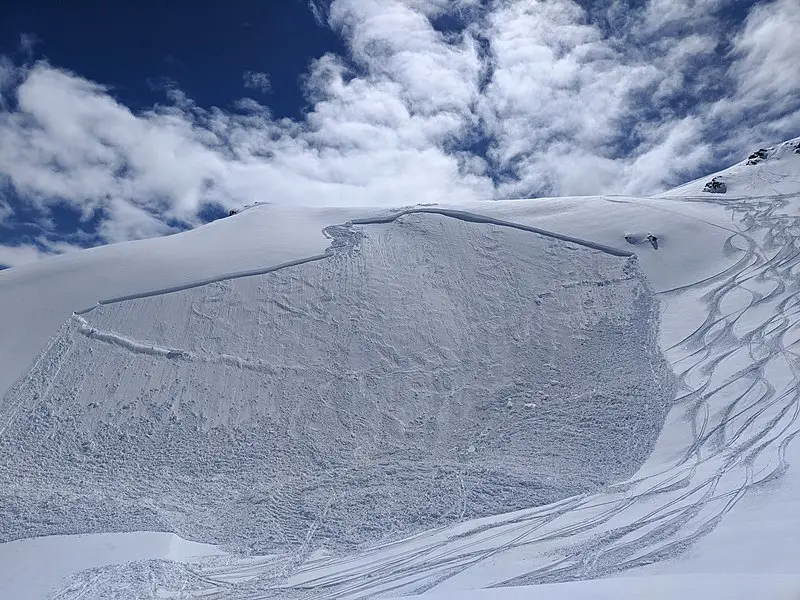Clare Vergobbi
The SNRA in winter is a magnet for winter sports enthusiasts, especially those who want to get away from the busy slopes of ski resorts and explore the backcountry in winter. With excellent backcountry skiing opportunities, plenty of groomed and ungroomed nordic ski trails, snowmobile trails, and snowshoe adventures, not to mention the nearby ski hills in Sun Valley, there are plenty of people recreating in the Sawtooth backcountry in the winter. But it’s not all fun and games – the backcountry in winter poses some very real dangers and challenges for adventurers, chiefly among them the threat of avalanches.

Thirty people died in avalanches in the United States in 2023, making it a particularly deadly year. Heavy snowfalls and extended winter conditions across much of the country contributed to these numbers, but 27 people die in avalanches in an average year. Dozens more are injured. Many ski resorts purposefully trigger avalanches when conditions are dangerous in order to protect the skiers on their slopes, but no one purposefully triggers avalanches in the backcountry. Those who plan to recreate in the backcountry must be aware of conditions, have an understanding of snow science, and be prepared.
First, a note on snow: snow falls when moisture in the air freezes and when the ground temperature is at or below freezing. Snowflakes themselves are flakes of crystallized ice, and snow on the ground is an accumulation of these packed ice crystals. The characteristics of this snowpack depends on a multitude of factors, including moisture content, temperature, depth, and weather. For example, in a storm with heavy winds the ice crystals tend to be smaller, broken up into bits that become more densely packed into drifts than they would on a still day, when the flakes fall in larger pieces and settle lightly. If snow remains on the ground the consistency changes through freeze-thaw cycles and it tends to grow more densely packed with time. Moisture content also affects the characteristics of snow. The Sawtooths tend to get a lot of dry snow, meaning it’s light and fluffy with a low moisture content and great for skiing! Moisture content of snow always depends on the storm and its duration, however, and sometimes we get heavy, wet snow, especially in warmer conditions in early winter or late spring. Think about how heavy snow can be to shovel some days when it seems lighter other days, or the difference between wet slush and light powder.
Where there is snow, there is avalanche danger. What changes are the conditions and likelihood of avalanche occurrences. Avalanches are usually caused by unstable snow conditions, which are in turn caused by weather, temperature, moisture content, and sun exposure–all of the factors that effect the characteristics of the snow itself. Snow is weighed down by gravity, so the more that piles up on a steep or vertical slope the more likely it is to succumb to gravity and fall. Gravity pushes the snow down into the ground, but also downslope. The steeper the slope, the more the gravity exerts downslope and the less stable the snow is. Avalanches can be triggered by movement, loud noises, wind, or rock and snowfalls.

Conditions that increase the likelihood of avalanche include precipitation in the form of snow or rain, windy conditions, and rapid temperature changes or big temperature swings–for example, if it gets above 32 degrees F during the day and then down into the negatives at night, causing freeze/thaw cycles. Weather events and temperature changes affect the base (any snow that fell previously to the most recent snowstorm). If the base layer is more or less frozen, has a higher or lower moisture content, or is more icy or compacted than the newest layer of snow, this can create unstable conditions. The newest layer of snow may not adhere to the base layer, or the base layer may be unstable beneath a seemingly stable fresh layer. Additionally, layers of snow within the base layer can be unstable. Moisture content also affects avalanche conditions: the higher the moisture content, the heavier the snow, and the higher the avalanche danger. Not only is the snow more likely to give way to gravity, it’s also more difficult to dig yourself or others out of.
The good news is, you’re not on your own when it comes to figuring out avalanche conditions. The Sawtooth Avalanche Center works out of Ketchum and is a Forest Service partner that keeps track of avalanches and avalanche conditions. They publish daily reports and have interactive condition maps on their website. If you are planning a trip into the backcountry, check out their website for detailed condition reports, avalanche warnings, and maps of different areas and current risk levels. They also have a youtube page with current conditions and reports from the field, and host events, field days, and classes on avalanche awareness and safety.
If you’re planning a winter adventure in the SNRA, be prepared! It’s a good idea to take an avalanche safety class through the Avalanche Center or another organization, bring safety gear, and be prepared to self-rescue if needed. Wear beacons and bring shovels, an avalanche probe, and other safety gear on backcountry adventures. Be sure to check weather reports, understand the snow conditions, and check the Avalanche Center’s website before you head out so you can enjoy the magnificent solitude of the Sawtooths in winter and come back safely at the end of the day.

For more information:
https://nsidc.org/learn/parts-cryosphere/snow/science-snow
https://www.sawtoothavalanche.com/
https://www.rei.com/learn/expert-advice/avalanche-reducing-risk.html?series=avalanche-awareness
https://www.rei.com/learn/expert-advice/avalanche-rescue-overview.html?series=avalanche-awareness
Clare Vergobbi is the summer programs coordinator for SIHA. When not talking about or exploring the Sawtooths, they enjoy baking bread, growing tomatoes, and reading a good book.